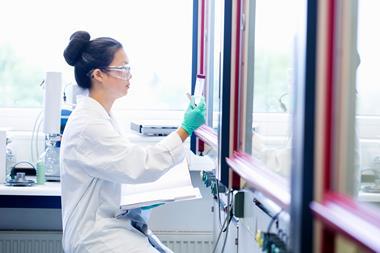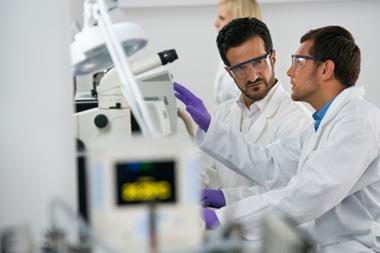More than 4000 PhD students will be trained over the next nine years in 65 centres recently approved by the Engineering and Physical Sciences Research Council (EPSRC). The programme will cost over a billion pounds with funding provided by the research council, industry and universities.
While total investment in Centres for Doctoral Training (CDTs) has risen from £944 million in 2018 (when the last funding round took place) to £1.09 billion, this funding will support 5% fewer students than five years ago. The UKRI blames the dip on cost increases.
EPSRC will provide £463 million from its core funding, compared with £436 million in 2018, with £16 million of additional UKRI funding to support CDTs in quantum technologies. £420 million comes from financial and in-kind support from business and charity partners – it was £386 million in 2018 – and £169 million from UK universities, compared with £122 million in 2018. The Ministry of Defence will invest £16 million in two CDTs and the Biotechnology and Biological Sciences Research Council will co-fund three at a cost of £7 million.
The idea behind CDTs is that they supply trained researchers in areas of strategic importance such as artificial intelligence, engineering biology, quantum technologies and semiconductors. Each CDT funded by EPSRC supports at least 50 students over the course of eight to nine years and involves one or more universities in partnership with businesses and other stakeholders.
CDTs are usually large, multidisciplinary collaborations. For example, the EPSRC CDT in aerosol science, led by Jonathan Reid, a physical chemist at the University of Bristol, involves eight universities providing £5 million, as well as over 80 industrial and public sector partners providing £6.5 million. Together with EPSRC investment of £8.2 million, this will fund over 90 PhD students.
‘CDTs are incredibly valuable, particularly for areas that are multidisciplinary,’ says Reid. ‘Without the CDT, we would just not be able to provide comprehensive training to the next generation of researchers in a field which is rarely touched on at undergraduate level in any degree subject. Our CDT involves academics from a wide range of disciplines spanning the physical, environmental and health sciences, and engineering. We have uniquely been able to bring together over 80 academics across these disciplines to support the training of our students. This would not have been possible without the CDT funding.’
Alessandro Troisi, a chemist at the University of Liverpool and lead for the EPSRC CDT in digital and automated materials chemistry, says that the CDTs are a unique funding instrument as they allow the reshaping of a research area through the training of many cohorts of graduates. ‘It is much more than one or a collection of multidisciplinary projects because it establishes a novel approach that will be propagated to many research teams affecting a generation of scientists. It is for this reason that many funded CDTs reflect an impending paradigm shift in research practice, in our case consisting in the adoption of robotics and data-centric methods in materials chemistry.’ However, he adds that the 5% drop in student numbers is ‘a worrying trend’.
The CDT model of PhDs shouldn’t be viewed in the same way as a standard PhD where a student undertakes research from day one, as the CDT provides a significant training component, Reid stresses.
‘CDTs offer the opportunity for students to learn as a cohort and develop the types of interactive, teamworking, collaborative skills that are sometimes missing from “traditional” PhD programmes but are key to future careers,’ explains Jonathan Clayden, an organic chemist at the University of Bristol and lead for the EPSRC CDT in technology-enhanced chemical synthesis. ‘In Bristol, we also use the CDT cohort model to allow students to choose and develop their own PhD projects during their first year – our model means that students have informed input into the project choice and develop a sense of “ownership” of their research work.’
Simon Aldridge, a chemist at the University of Oxford and lead for the EPSRC CDT in inorganic materials for advanced manufacturing, has found that CDTs attract an extraordinarily high calibre of students. ‘CDTs provide a very high quality, focused training, targeted at areas of national importance. [But] they are also quite a lot of work putting together the graduate courses involved.’
Applying for a CDT is also very time-consuming and highly competitive. ‘The multi-stage application process occupied a significant part of my time for the whole of 2023 – putting together the various documents, recruiting industry partners etc,’ says Aldridge. ‘Then there were somewhere between 300 and 400 bids for the 65 centres ultimately funded.’ The overall success rate appears to have been between 10–15%.












No comments yet